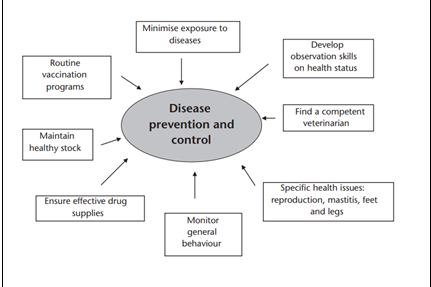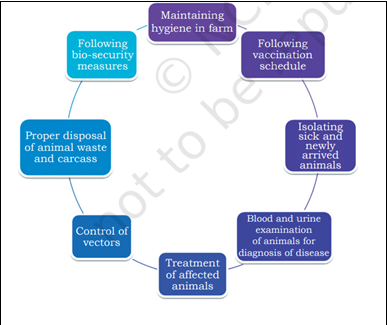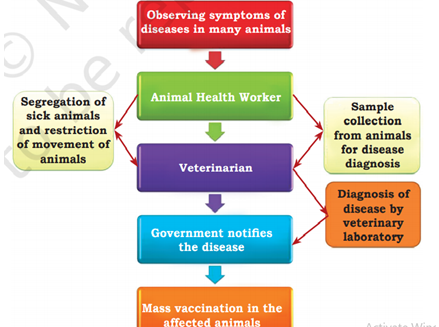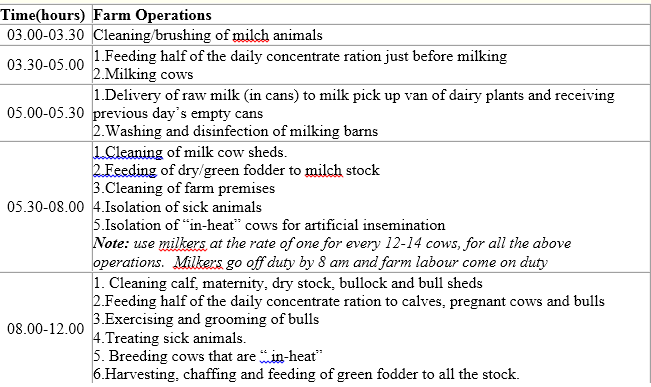Organic Dairy standards for Disease Prevention and Control
Back
Animal Disease Prevention and Control for Organic Dairy Farming
1. If any illness occurs, farmer should try to find out the cause and change / manipulate the management practices to prevent future outbreaks ?

Identification of risk factors for disease
Identifying factors that increase the risk of disease or those that reduce the risk of disease (protective factors) is important so that potential measures can be implemented to either reduce disease or prevent its entry.
Risk or protective factors for a disease can be demographic, husbandry/management, environmental, or socioeconomic factors, and are assessed by conducting descriptive epidemiological studies (cross-sectional, case-control, or cohort studies).
Major Route of Transmission:

Measures for controlling outbreak of animal diseases:

Reporting mechanism in case of epidemics in farm animals:

2. In ODF conventional medicine (allopathic) can be used when no other alternative is available.
The use of conventional veterinary medicines allowed when no other justifiable alternative is available with the withholding period being twice the legal period. Organic certifiers require written verification from a veterinarian to confirm the presence or threat of disease infection prior to approving the application of the treatment.
Where conventional veterinary medicines are used, the withholding period shall be at least double the legal period .
3. Exceptions:
If the animal is on allopathic treatment for two subsequent times in a year, then it loses its organic status for that year.
4. Prohibited
Genetically produced vaccines are prohibited in organic dairying.

5. Under ODF, instead of relying on medicines, animal’s immunity should be be strengthened so that immune system can do the job.
• Dairy cattle are susceptible to increased incidence and severity of both metabolic and infectious diseases during the periparturient period.
• A major contributing factor to increased health disorders is alterations in bovine immune mechanisms. Indeed, uncontrolled inflammation is a major contributing factor and a common link among several economically important infectious and metabolic diseases including mastitis, retained placenta, metritis, displaced abomasum, and ketosis.
• The nutritional status of dairy cows and the metabolism of specific nutrients are critical regulators of immune cell function. There is now a greater appreciation that certain mediators of the immune system can have a reciprocal effect on the metabolism of nutrients. Thus, any disturbances in nutritional or immunological homeostasis can provide deleterious feedback loops that can further enhance health disorders, increase production losses, and decrease the availability of safe and nutritious dairy foods for a growing global population.
• Diseases of food animals represent a major deterrent to a profitable and sustainable animal agriculture sector. Dairy cattle in particular are susceptible to increased incidence and severity of both metabolic and infectious diseases during the periparturient period.
• Health problems occurring around the time of parturition are especially problematic because they greatly affect the productive efficiency of cows in the ensuing lactation. Direct economic losses associated with periparturient health disorders include reductions in the cow’s productive capacity and increased mortality rates.
• Dairy cows are susceptible to a higher incidence and severity of metabolic and infectious diseases. The immune system serves as a defense mechanism against pathogens that the cow may come into contact with. In the healthy cow, the immune system will prevent these pathogens from causing various diseases.
• However, the immune system can be weakened due to the increased stress caused by calving, lactation, and heat. Improving your herd’s immune system will help prevent infections, reduce the cost of treatment and boost milk production and fertility.
To increase your dairy cattle immunity, take the following steps:
• Supplement nutrition during gestation and calving
• Provide natural supplements that have prebiotic effects
• Reduce the adverse effects of extreme temperatures through good management practices
• Perform regular checks on your cattle with your vet’s help
Strategies to improve cow’s immunity
Transition cows, or those cows facing the time period just before, during, and after calving, benefit from extra attention and care. List of top five strategies to help these special cows.
1. Manage body condition. “It’s the best proven way to minimize risk of transition cow disorders.
2. Housing. “It’s the second best way to reduce poor immune function by providing enough stall space and limiting overcrowding, dairy farmers can reduce stress caused from heat and stress incurred when submissive cows encounter dominant cows.”
3. Antioxidants. compounds such as vitamin E and selenium stimulate immune function. And a healthy immune system helps transition cows thwart disease.
4. Anionic diets. “To reduce milk fever and improve transition cow health, anionic diets fed prior to calving improve immunity
5. Tweak immunity. “There are naturally occurring compounds that, when fed to cows, could improve immune function..”
Common Vices of animals, their prevention and control
o Vices are abnormal or bad habits shown by the animals.
1. Eye rolling
• The eyes are moved around in the orbit at a time when no visible object is present.
• Normally seen in calves confined in crates and stand immobile for extended period.
2. Tongue rolling
• The tongue is extruded from the moth and moved by curling and uncurling outside or inside the mouth with no solid material present.
• This condition occurs in all ages and breeds but young adult cattle and certain breeds such as Brown Swiss are exhibiting it most frequently.
• Factors responsible for these vices may be hereditary, continuous confinement, feeding of low roughages.
• Control method includes dietary inclusion of salt mixture, free movement.
3. Licking and eating own hair, wool
• Many young calves housed in individual crates, early weaning leads to licking those parts of their bodies which they can reach, this results in ingestion of large quantities of hair wic aggregates into hair balls or bezoars in the rumen.
• This vice is more common in calves moved from individual pen to group housing.
4. Sucking and eating solid objects
• Recently weaned calves will often suck and lick the walls, bars of their pen.
• This can be controlled by regular creosote paint of wood surface. Feeding good quality concentrate and roughage will minimize the incidence.
5. Intersucking by calves
• Calves separated from their mothers suck and lick at their own bodies, at objects in their pens and at parts of the bodies of other calves.
• The commonly suck on the navel, prepuce, scrotum, udder and ears of other animals.
6. Intersucking or milk sucking by adult animals
• This behavior involves a cow or bull sucking milk from the udder of a cow.
• Cattle suck milk from herd mates and choose the same lactating animal.
• This vice may lead to loss of milk yield and damage to teat.
• Proper feeding management and herd supervision can minimize such incidents
Daily farm routine or day-to-day operation in an ideal dairy farm


